 Music
Music  Music
Music  History
History 10 Less Than Jolly Events That Occurred on December 25
 Weird Stuff
Weird Stuff 10 Funny Ways That Researchers Overthink Christmas
 Politics
Politics 10 Political Scandals That Sent Crowds Into the Streets
 Weird Stuff
Weird Stuff Ten Bizarre Facts About The Doge Meme
 Our World
Our World 10 Ways Your Christmas Tree Is More Lit Than You Think
 Movies and TV
Movies and TV The 10 Coolest Stars to Set Sail on The Love Boat
 History
History 10 Things You Didn’t Know About the American National Anthem
 Technology
Technology Top 10 Everyday Tech Buzzwords That Hide a Darker Past
 Humans
Humans 10 Everyday Human Behaviors That Are Actually Survival Instincts
 Music
Music 10 Surprising Origin Stories of Your Favorite Holiday Songs
 History
History 10 Less Than Jolly Events That Occurred on December 25
 Weird Stuff
Weird Stuff 10 Funny Ways That Researchers Overthink Christmas
Who's Behind Listverse?

Jamie Frater
Head Editor
Jamie founded Listverse due to an insatiable desire to share fascinating, obscure, and bizarre facts. He has been a guest speaker on numerous national radio and television stations and is a five time published author.
More About Us Politics
Politics 10 Political Scandals That Sent Crowds Into the Streets
 Weird Stuff
Weird Stuff Ten Bizarre Facts About The Doge Meme
 Our World
Our World 10 Ways Your Christmas Tree Is More Lit Than You Think
 Movies and TV
Movies and TV The 10 Coolest Stars to Set Sail on The Love Boat
 History
History 10 Things You Didn’t Know About the American National Anthem
 Technology
Technology Top 10 Everyday Tech Buzzwords That Hide a Darker Past
 Humans
Humans 10 Everyday Human Behaviors That Are Actually Survival Instincts
Top 10 Origins Of Popular Desserts
Desserts around the world have come a long way since they were first made. Dainty versions of well-known desserts stand out in the windows of patisseries, and multiple flavor variations are experimented with to replace the standard chocolate and vanilla. Mirror glazed cakes, where one can see their reflection as they are about to take a bite of all those calories, have become the latest internet sensation. Hybrids such as the cronut are making their way into cafés and bakeries.
Many desserts started as savory dishes and were only affordable by the rich. Some desserts did not even use sugar for sweetener, unlike the sugar laden desserts we have today, but all of these sweet treats that are loved today started somewhere.
10Custard

Custard has been used as a base or filling for several desserts including crème brules and some ice-cream bases. It is also enjoyed on its own or heated and poured over warm puddings. It was the ancient Romans who first discovered that eggs could bind with other ingredients. They created several dishes from this discovery and either made them savory or sweet. However, it is generally accepted that it was in the Middle Ages that the sweet, creamy-textured custard we know today was created.
The milk and egg mixture, which is heated to thicken, was used to fill pies and flans. This is also where the English word for custard comes from—the word “croustade”[1] which means something with a crust or a pastry—as it would be used for fillings.
When one is too lazy and does not have the patience to stand and whisk away at homemade custard to go with a shop bought sticky toffee pudding, there is always the convenience of custard powder. That is all thanks to Alfred Bird. Bird invented instant custard powder in 1837 when he decided to create an egg free alternative of custard for his wife who was allergic to eggs. He was also the inventor of baking powder.
9Sorbet

What is the first thing you think of when it starts to snow? Snow angels? Snowball fights? Sledding? Mixing it with some fruit juice and eating it? No? Okay.
As far back as 3000 B.C., ancient civilisations began flavoring crushed ice. It is believed to have started in Asia where it was served to the Emperors. Alexander the Great enjoyed eating snow with honey, and the Roman Emperor Nero had runners who would fetch snow to mix with fruits and juices so that he could enjoy the frozen treat.[2]
The difficulty in finding ice or snow, and maybe also the fact that not everyone had servants to go and fetch ice for them, made the dessert a very expensive food. It was not until the 20th century that sorbet, as well as ice-creams, became more available and cheaper for anyone who wanted them.
8Rice Pudding
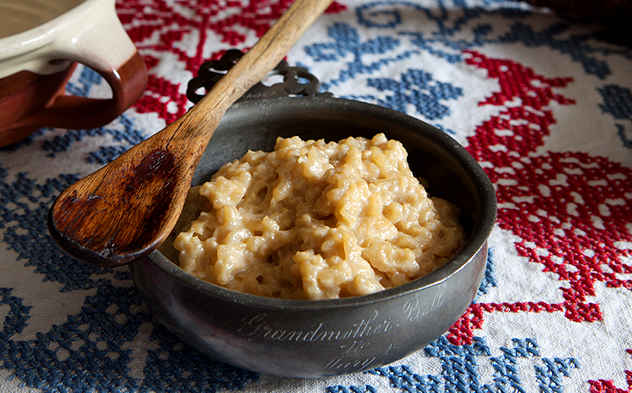
Rice pudding desserts have not necessarily got a specific time and place of origin. Its origin is more of how it evolved from being used for medicinal purposes, to becoming a savory dish and then a sweet dessert.
Rice was used in Asia for the treatment of digestive ailments. It is believed that medicinal rice puddings could have been created in Ancient China, India, or Persia, and it is known that a similar dish of grain pottages was made in the Middle East. Rice made its way to Europe from India where savory rice puddings became popular. They were usually made with salt, broth, saffron, and almond milk.[3] It is from this that the sweetened rice puddings were created.
The earliest known sweetened rice pudding dates back to around the 1400s in England. These recipes included honey, sugar, spices, and currants which were stuffed into sausage skins. Rice was an expensive import and sugar was expensive too, therefore, like most desserts at the time, rice puddings were only affordable by the rich. It was not until the 18th century when rice imports became more common that rice pudding became more affordable, and by the 19th and 20th centuries it became a cheap, everyday food.
Rice pudding is found all around the world today, and each culture has its own preferences as to what should go into it. They can be made with different kinds of milk, fresh and dried fruit can be included, different spices are used, and it can be served hot or cold. Even sugar is optional. So the once humble pottage used only to treat stomach ailments has now become a yummy dessert enjoyed around the world.
7Shortbread

Imagine only being able to eat this buttery, crumbly biscuit on one or two occasions a year. Shortbread, which originated in Scotland, was an expensive treat that was usually had as a luxury by the non-wealthy for special occasions like Christmas and weddings. Today it is sold in abundance and is enjoyed all year round.
Although shortbread is attributed to Mary, Queen of Scots, who during the 16th century enjoyed a version of shortbread called a Petticoat Tail, described as thin, crisp, and of course buttery, the shortbread we know today evolved from medieval biscuit bread from the 12th century. Leftover bread dough was usually rolled in spices and a bit of sugar and then baked at a low heat until it dried out into a form of rusk. At some point, the yeast in the dough was swapped out for butter (shortening), and that is how shortbread was first made. It was traditionally cut into three different shapes, “fingers,” “Petticoat Tails” (a large circle that is cut into triangles), and “shortbread. rounds” all of which are still used today.[4]
6Gelatin Desserts

This popular type of dessert is loved for its numerous flavors and bright colors. It can be layered or molded into any shape, and it wobbles! It is a fun dessert for all ages! However, this pretty looking dessert has a not so pretty origin. Yes, gelatin creates not only sweet treats, but it can also be used for savory purposes—and that is how the dessert we love today started.
So here is the fun part—the production of gelatin dates back to the 1400s. It began as an incredibly slow process of boiling down animal skin and bones for hours to release the collagen in them. The earliest known recipes for those savory, gelatin based dishes involved boiling pigs ears and feet which were rich in collagen.[5] It was a sign of wealth if one was able to pay their staff for the skill and time needed to make gelatin, and the dishes prepared using gelatin were show pieces at dinner parties. At the time, gelatin was not popular for sweet dishes as it would have given a meaty taste to them, so it was used more for preserving, glazing, and binding.
During the Industrial Revolution, flavorless gelatin began being produced in packaged dried leaves. In 1845, a man named Peter Cooper decided to switch from glue production to producing gelatin dessert mixes. His recipe included sugar, spices, eggs, and processed lemons mixed in with powdered gelatin. However, it was not a popular product at all. Then in 1887, a husband and wife—Pearle. B and May Wait—decided to flavor gelatin powder. They added artificial fruit flavors and lots of sugar, and then gave this powdered dessert mix a name that is now known very well today: Jell-O. Unfortunately, the product was not very successful at first, and it was not until a company, owned by a man named Frank Woodward, took over the trademark and recipe that it became a hit. Today, both homemade and premade gelatin dessert mixes are a popular treat.
5Pavlova
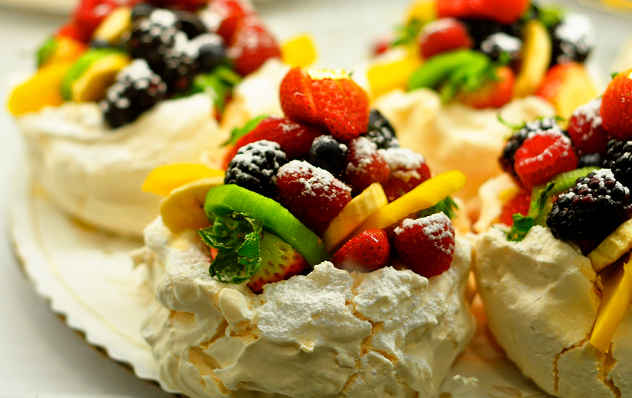
Pavlova . . . a dessert named after a Russian ballerina with the title of inventor fought over by Australia and New Zealand. But actually, it should be credited to America, as well as Austria and Germany where the first known origin of the dessert comes from. The meringue, cream, and fresh fruit layered dessert may sound simple enough, but the first known recipe of a similar creation dates back to the 18th century, where Austrian Habsburgs ate a masterpiece of a dessert called a Spanische Windtorte. The dessert was beautiful to look at for its intricate piping of the meringue, and once cut open, its colorful layers of fresh fruit and cream.
Other similar torte recipes were taken to America by German immigrants, and there were approximately 150 similar meringue based cakes that were made before 1926 when Anna Pavlova visited Australia and New Zealand. Pavlova, a world-class ballerina, had the dessert made and named in her honor. However, the pavlova specifically named after her was actually a layered gelatin dessert. It was only in 1929 that a New Zealand chef created a meringue dessert with cream and kiwi fruit that was inspired by Anna Pavlova’s tutu. This led to the New Zealanders’ claim that they invented the pavlova we have today.[6]
But here is another big, however! The Australians also claimed to be the inventors of the modern pavlova, because when they created a crunchier meringue layered with cream and passionfruit in a Perth hotel in 1926, it was stated by a guest that it was, “as light as Pavlova.” Therefore the chef decided to name it after Anna Pavlova. So, the Australians like to believe that they created the modern dessert and the New Zealanders named it. Although neither New Zealand nor Australia truly holds the title, the dessert is still incredibly popular and will always be a part of their cultures and histories.
4Macaroons
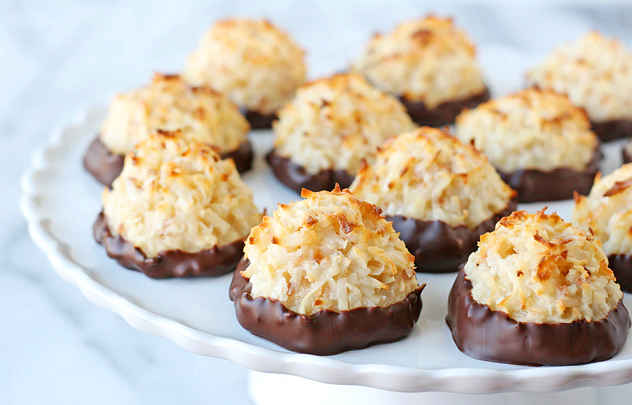
Macaroons are often confused with macarons because of how some people pronounce the brightly colored macarons as macaroons. They look and taste completely different. However, they are very much linked in their origins.
The origin of the macaroon, a crispy golden baked coconut cookie, began in Italian monasteries around the 8th or 9th century.[7] It started out with what is now known as the amaretti. Bakers decided to get creative and swap out the almond paste for shredded coconut around the 1890s when the almond cookies were found to be too fragile for shipping. It was a very popular treat amongst Jews when it was created as it was flourless and unleavened, meaning it was a perfect treat for Passover. This led to further flavor adaptions of the cookie such as chocolate and coffee.
3Macarons
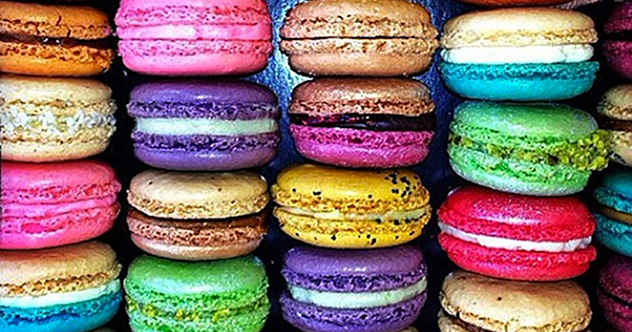
The crunchy shelled macaron with creamy, flavorful fillings is the sister of the macaroon. But how do the very different looking treats come from the same original recipe? Well, this is where France comes in. Bakers in Italy took the same almond paste amaretti and swapped in almond flour. Ta-da! Thus the overly priced and difficult to make macaron that we love today was born! But it is widely believed that in the 16th century it was Catherine de’ Medici who brought the early version of today’s macaron to France where its popularity soared for centuries.
The story of how the macaron became so popular is not such a happy one though. It was in 1792 during the French Revolution that two nuns, later known as the “Macaron Sisters,” baked and sold the treat in order to survive.[8] As the macaron recipe kept evolving, it was in the French Capital around the 1830s that bakers began making two separate, equally sized cookies between which they put either jam or another filling. This is the macaron we know today. Macaron recipes evolved even further, and chefs today are still experimenting with flavor and filling combinations for the crunchy yet chewy treat.
2Cheesecake
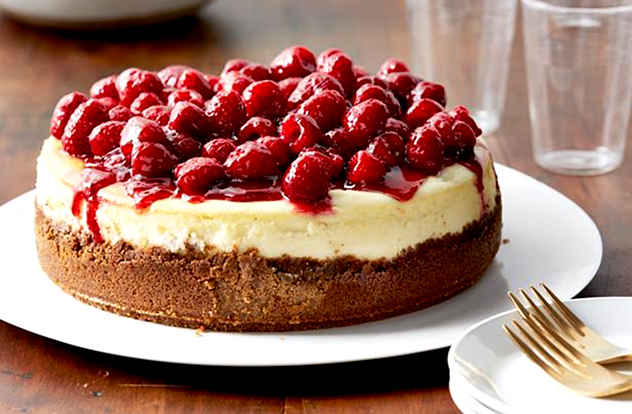
Baked. Refrigerated. Chocolate. Berry. New York. Cookie Dough. Red Velvet . . . The list of cheesecakes today is never ending. The bases can be made from any biscuit or cookie desired. The top of the cake can be smothered in melted chocolate or decorated with brightly colored fruits. The numerous recipes today, however, are slightly more complicated than the first cheesecake recipes. Originally, they were made of wheat, flour, honey, and cheese and then baked.[9] Try impressing your guests with that at your next tea party.
Cheesecake has had over 4000 years since its invention in Greece to evolve into what it is today. It is possible that the Greek Island of Samos was where the first cheesecake was made. It was considered by the Greeks to be a source of energy and was even eaten by athletes at the first Olympic Games. It was also a popular option of brides and grooms for their wedding cake.
It was thanks to an accidental discovery that cream cheese is now a common main ingredient used in cheesecakes. Cheesecake recipes had already reached America thanks to immigrants, but in 1872, while trying to recreate a French cheese called Neufchatel, William Lawrence accidentally discovered a process that resulted in cream cheese. This cream cheese was distributed in foil packaging and became known as Philadelphia Brand Cream Cheese.
1Apple Pie
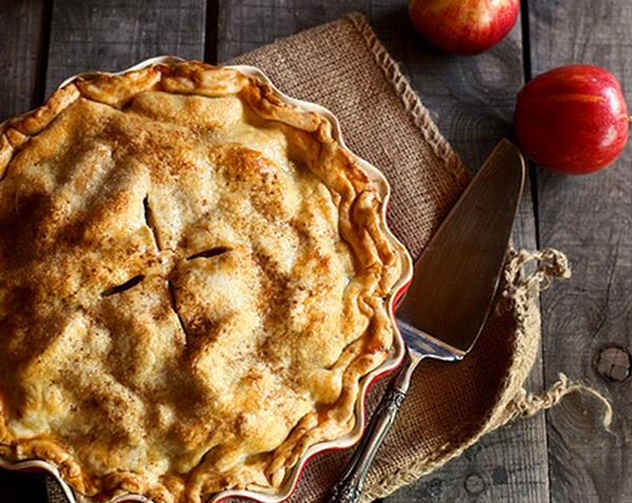
Bad news America, “As American as Apple Pie” does not tie up with the origin of apple pie. In fact, apple pies were being made long before colonists brought apple seeds to the New World, and the only apple native to the United States is the crab apple.[10]
The first recorded apple pie recipe dates back to 1381 in England, where the recipe called for apples to be combined with other fruits such as raisins, figs, and pears, as well as saffron. Pies today are most often sweetened with sugar but back then sugar was very expensive, and desserts that were sweet had honey in them instead. Early known pie shells were called “coffins” and were actually inedible. Think of it like a disposable baking dish made from pastry. However, they were convenient for transporting the filling inside. Eventually, in the 1500s, recipes started improving for the pastry shells, and the whole pie became a tasty treat.
Kerri Lee lives in Johannesburg, South Africa working as a singing teacher. She has a degree majoring in Screen Writing and found this to be a great way to write while hiding from the film industry.
Read more about the history of food on 10 Of The Strangest Foods People Ate Through History and 10 Common Misconceptions About Food Origins.








